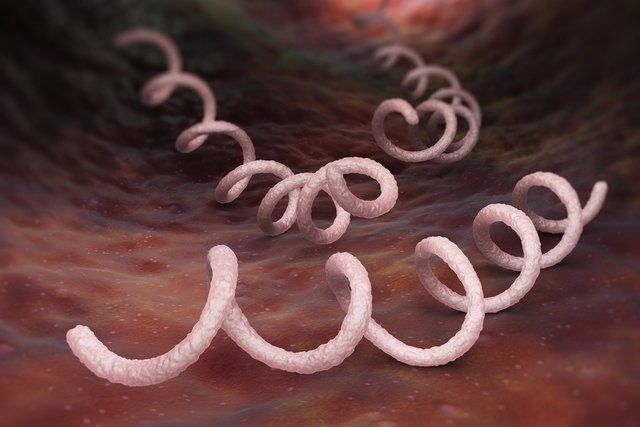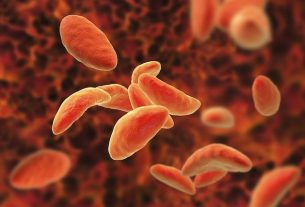Tertiary syphilis is the last stage of syphilis infection (Treponema pallidum)in which the bacteria, which was not identified or fought correctly in the early stages, remains in the body and multiplies in the bloodstream, spreading to other organs.
The symptoms of tertiary syphilis appear years after the appearance of the first symptoms of syphilis, and are related to the progressive inflammation caused by the bacteria, resulting in the involvement of several organs and the appearance of various signs and symptoms of this phase of the infection.
It is important that tertiary syphilis is identified and treated according to the doctor’s recommendation, as this not only prevents transmission to other people, but also promotes the elimination of the bacteria and reduces symptoms, improving quality of life.

Symptoms of tertiary syphilis
The main symptoms of tertiary syphilis are:
- Appearance of ulcerated lesions on the skin, which can also affect the bones;
- Neurosyphilis, in which the bacteria affects the brain or spinal cord;
- Meningitis;
- Seizures;
- Cardiac changes due to the proliferation of bacteria in the heart and blood vessels;
- Hearing Loss;
- Blindness;
- Frequent nausea and vomiting;
- Mental confusion and memory loss.
Symptoms of tertiary syphilis can appear 2 to 40 years after the first symptoms of primary syphilis appear and are mainly related to the spread of the bacteria through the bloodstream and multiplication in other organs.
The symptoms of tertiary syphilis appear progressively due to inflammation caused by the persistent presence of the bacteria in the body, which leads to dysfunction of various organs and can result in death if not identified and treated. Therefore, as soon as the presence of any signs or symptoms indicative of tertiary syphilis is verified, it is important to go to the infectious disease specialist or general practitioner so that the evaluation can be carried out, the diagnosis confirmed and treatment started.
Online symptom test
To find out if you have syphilis, please select the symptoms you present:
This test is a tool that serves only as a means of guidance, and is not intended to provide a diagnosis or replace consultation with a urologist, gynecologist or infectious disease specialist.
How the diagnosis is made
Tertiary syphilis is most often identified after the appearance of signs and symptoms of this stage of the disease, and the person should go to an infectious disease specialist or general practitioner to have tests carried out and the infection to be confirmed.
If you want to make an appointment, you can find the doctor closest to you using the tool below:
Taking care of your health has never been easier!
Among the tests indicated by the doctor to identify the infection by Treponema pale is the VDRL test, which checks the levels of antibodies in the blood against the bacteria, making it possible to determine the severity of the infection. Understand how the VDRL exam is performed.
Treatment for tertiary syphilis
Treatment for tertiary syphilis is carried out with the aim of reducing the quantity and promoting the elimination of the bacteria responsible for the disease, preventing it from continuing to proliferate and spread to other organs. Therefore, the doctor recommends at least 3 injections of penicillin, with an interval of 7 days between doses, as well as the use of other antibiotics, such as Doxycycline and/or Tetracycline, in some cases. See more details about the treatment for syphilis.
However, as more serious symptoms are identified in tertiary syphilis, the doctor may recommend other treatments with the aim of treating complications, promoting the person’s quality of life.
It is important that the person regularly performs the VDRL test to check whether the treatment carried out is being effective, otherwise adjustments may be made to the dose of the medication.
Check out more information about syphilis in the video below:
Bibliography
- MAHON, Connie R.; LEHMAN, Donald C. Textbook of Diagnostic Microbiology. 6 ed. St- Louis, Missouri: Elsevier, 2019. 524-525.
- BARRER, Michael R et al. Medical Microbiology: A guide to microbial infections – pathogenesis, immunity, laboratory investigation and control. 19 ed. Elsevier, 2018. 318-319.
- MINISTRY OF HEALTH. Syphilis. Available at: <http://www.aids.gov.br/pt-br/publico-geral/o-que-sao-ist/sifilis>. Accessed on June 30, 2020
- MINISTRY OF HEALTH. Syphilis: what it is, causes, symptoms, treatment, diagnosis and prevention. Available at: <https://www.saude.gov.br/saude-de-az/sifilis>. Accessed on June 30, 2020
- CDC. 2015 Sexually Transmitted Diseases Treatment Guidelines: Syphilis. Available at: <https://www.cdc.gov/std/tg2015/syphilis.htm>. Accessed on June 30, 2020
- Ministry of Health. Clinical Protocol and Therapeutic Guidelines (PCDT): Comprehensive Care for People with Sexually Transmitted Infections (STIs). 2nd ed. Brasília: 2015. 97-98.

Sign up for our newsletter and stay up to date with exclusive news
that can transform your routine!
Warning: Undefined array key "title" in /home/storelat/public_html/wp-content/plugins/link-whisper-premium/templates/frontend/related-posts.php on line 12
Warning: Undefined array key "title_tag" in /home/storelat/public_html/wp-content/plugins/link-whisper-premium/templates/frontend/related-posts.php on line 13




